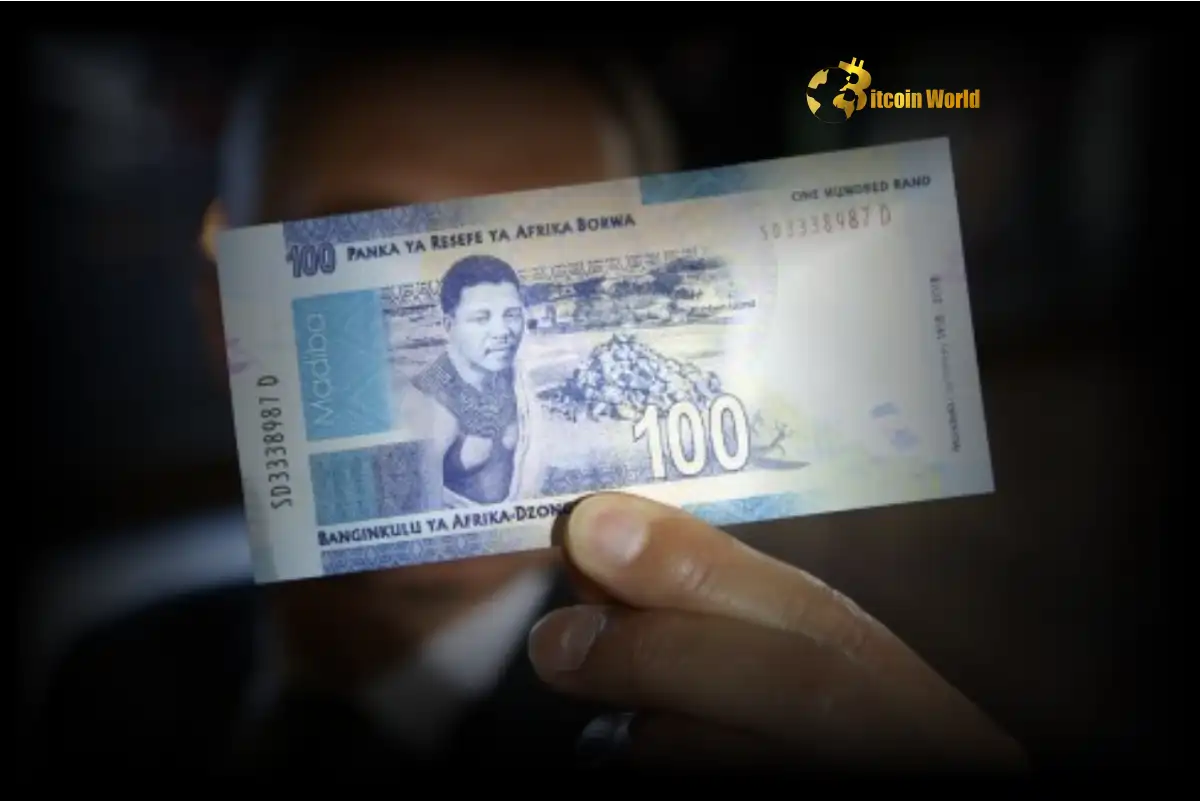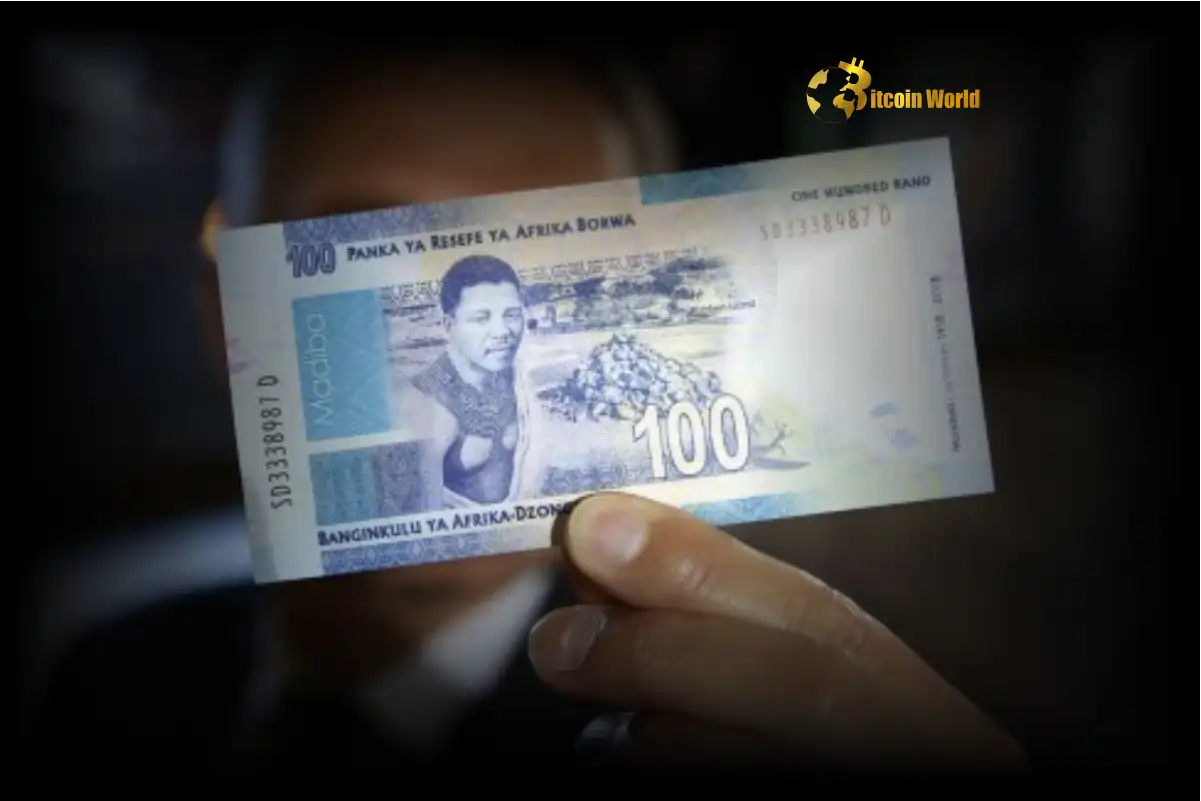BitcoinWorld

USD ZAR Forecast: Bank of America Makes Stunning Shift, Turns Bullish on South African Rand
In a move capturing significant attention in global financial markets, Bank of America (BofA) has announced the closure of its long-standing short position against the USD ZAR currency pair. This strategic decision signals a notable shift in the institution’s outlook, moving from a bearish stance on the South African Rand to a distinctly bullish one. For those involved in currency trading, especially pairs involving emerging markets, this development from a major player like BofA warrants close examination.
Understanding the Shift: Why is Bank of America Bullish on the South African Rand?
Bank of America’s change in perspective didn’t happen in a vacuum. Their decision to close the short USD ZAR trade is reportedly based on a reassessment of several factors influencing the South African Rand’s potential performance. While specific internal analysis details remain proprietary, market observers point to a confluence of domestic and international elements contributing to this revised Forex forecast.
Key reasons cited or speculated upon for BofA’s bullish turn include:
- Improving Global Risk Sentiment: A general improvement in global economic outlook or a reduction in risk aversion can benefit emerging market currencies like the Rand. When investors feel more confident, they tend to seek higher yields available in developing economies.
- Potential for Domestic Reforms: Hopes for policy stability or structural reforms within South Africa, even if incremental, could be viewed positively by international banks like Bank of America. Reduced political uncertainty or steps towards fiscal consolidation can enhance investor confidence.
- Commodity Price Strength: South Africa is a major exporter of commodities, including precious metals and minerals. Sustained or rising prices for these exports can boost the country’s trade balance and support the Rand’s value.
- Technical Market Factors: Beyond fundamental analysis, technical indicators in the USD ZAR pair might have signaled a potential reversal or exhaustion of the previous trend, prompting BofA to adjust its position.
- Reduced USD Strength Expectation: If BofA’s broader Forex forecast includes an expectation of the US Dollar potentially weakening against a basket of currencies, this would naturally make a short USD ZAR position less attractive or a long Rand position more appealing.
This shift from a major institution like Bank of America is significant because it can influence other market participants and potentially contribute to the very move they are now forecasting.
What Does This Mean for USD ZAR Currency Trading?
For individuals and institutions engaged in currency trading, particularly in the USD ZAR pair, BofA’s call serves as a key piece of market intelligence. While no single bank’s view guarantees future price movements, such pronouncements from major players are closely watched and often factored into trading strategies.
Here are some potential implications:
- Increased Rand Buying Interest: Other market participants may interpret BofA’s move as a signal and increase their own buying of the South African Rand, potentially putting downward pressure on the USD ZAR exchange rate (meaning the Rand strengthens against the Dollar).
- Shift in Market Sentiment: The news can contribute to a broader positive sentiment surrounding the South African Rand, potentially attracting more capital flows into South African assets.
- Volatility: As positions are adjusted and new ones are initiated based on this view, the USD ZAR pair could experience increased volatility in the short term.
- Re-evaluation of Existing Positions: Traders holding short USD ZAR positions (betting on Rand weakness) might reconsider their strategy in light of BofA’s bullish Forex forecast.
It’s crucial to remember that market dynamics are complex, and BofA’s view is one of many factors at play. Traders should always conduct their own analysis and manage risk effectively.
Comparing Forex Forecasts: Is BofA Alone in its Bullish USD ZAR View?
While Bank of America’s shift is noteworthy, it’s valuable to see how their Forex forecast for USD ZAR compares to other major financial institutions. The landscape of currency predictions is diverse, and consensus often evolves.
Historically, forecasting emerging market currencies like the South African Rand has been challenging due to sensitivity to global risk appetite, commodity prices, and domestic political and economic developments. Different banks and analysts weigh these factors differently, leading to varied predictions.
A simplified comparison might look like this:
| Institution (Example) | Previous USD ZAR Stance (Example) | Current USD ZAR Stance (Post-Announcement) |
|---|---|---|
| Bank of America | Bearish Rand (Short USD/ZAR) | Bullish Rand (Implied Long Rand Position) |
| Institution B (Hypothetical) | Neutral/Slightly Bearish | Watching/Evaluating BofA’s rationale |
| Institution C (Hypothetical) | Moderately Bullish Rand | Reinforced Bullish View |
This table is illustrative. Real-world Forex forecast details involve specific target levels and timeframes. The key takeaway is that BofA’s move might prompt others to revisit their own models and assumptions regarding the South African Rand.
Challenges and Risks to the South African Rand’s Bullish Outlook
Despite Bank of America’s positive view, the path forward for the South African Rand is not without potential hurdles. Currency trading involves inherent risks, and several factors could challenge a sustained bullish trend in the USD ZAR pair.
Potential challenges include:
- Domestic Economic Weakness: Ongoing structural issues within the South African economy, such as high unemployment, inequality, and infrastructure constraints (like power shortages), could weigh on investor sentiment.
- Political Uncertainty: Future political developments or policy shifts could introduce volatility and deter investment.
- Global Economic Slowdown: A significant downturn in the global economy would likely reduce demand for commodities and increase risk aversion, negatively impacting the Rand.
- Changes in Monetary Policy (Local and Global): Decisions by the South African Reserve Bank (SARB) or major central banks like the US Federal Reserve can significantly influence interest rate differentials and capital flows, affecting the South African Rand.
- Unexpected Shocks: Geopolitical events, natural disasters, or other unforeseen crises can rapidly alter market dynamics and currency valuations.
Therefore, while Bank of America’s bullish stance is a positive signal, market participants must remain aware of these potential headwinds.
Actionable Insights for Currency Trading Participants
What should traders and investors take away from this development regarding the USD ZAR pair and the South African Rand? BofA’s move is a prompt to re-evaluate existing strategies and consider potential opportunities.
Here are some actionable insights:
- Review Your Position: If you hold a currency trading position in USD ZAR, assess how BofA’s view aligns with your own analysis. Consider whether adjustments are necessary.
- Conduct Independent Research: Do not rely solely on BofA’s call. Investigate the underlying reasons for their shift and conduct your own fundamental and technical analysis of the South African Rand and the USD ZAR pair.
- Monitor Key Data: Keep a close eye on South African economic data (inflation, growth, trade balance) and political developments, as well as global factors like commodity prices and US monetary policy expectations. These will influence the Forex forecast.
- Consider Risk Management: If you decide to take a position based on a more bullish outlook for the Rand, ensure you have appropriate risk management strategies in place, such as setting stop-loss orders.
- Look at Related Assets: A bullish view on the Rand might also have implications for South African bonds and equities.
This is not financial advice, but rather a guide to how market participants might react to significant news from institutions like Bank of America regarding their Forex forecast.
Conclusion: A Noteworthy Shift in the USD ZAR Landscape
Bank of America’s decision to exit its short USD ZAR position and adopt a bullish stance on the South African Rand marks a significant moment for the currency pair and the broader emerging markets currency trading space. It suggests that, from BofA’s perspective, the balance of risks and potential rewards for the Rand has shifted favorably.
While the reasons behind this move likely involve a complex interplay of global and domestic factors, the signal itself is clear: a major financial player sees potential for the Rand to strengthen against the US Dollar. This does not eliminate the inherent volatility and risks associated with emerging market currencies, but it does provide a notable data point for anyone involved in or considering currency trading of the USD ZAR pair.
As always, successful currency trading requires diligence, ongoing analysis, and careful risk management. BofA’s Forex forecast adds a compelling element to the current market narrative for the South African Rand.
To learn more about the latest Forex market trends, explore our article on key developments shaping currency trading and Forex forecasts.
This post USD ZAR Forecast: Bank of America Makes Stunning Shift, Turns Bullish on South African Rand first appeared on BitcoinWorld and is written by Editorial Team





